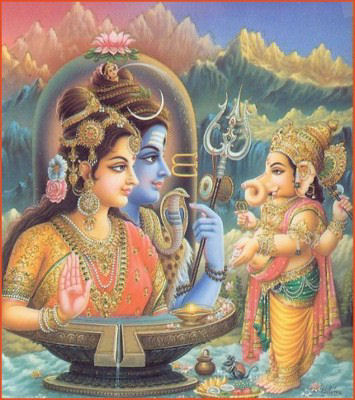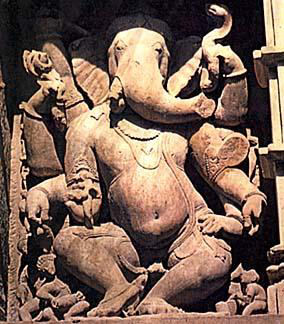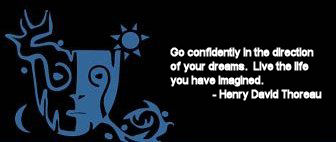
The Yoga of Darkness
Duality in New Age Culture
By Derek Beres

Bendable yoginis postured atop freefalling clouds in blue skies. Sagely men costumed in robes
and long white beards, staring contemplatively, perhaps compassionately. Peaceful elephant gods
munching galub jamon while conversing with friendly rats. Krishna and Radha wrapped in loving arms,
flutes pressed tightly against wistful lips. Siva dancing, yet all we see are flowers growing
beneath his feet. The destruction is gone.
The American editing of yoga reminds one of what Bible scriptwriters must have endured during
deadline week. The advertising of this serene tonic as a certain path to bliss, reconciling body,
mind and spirit, and other promises of New Age marketers has created a dangerous stigma around
the discipline of what is purported to be an ancient art form. Reality tells a different story
altogether.
Much as the Christian mindset divides heaven and hell into opposing forces, the world of yoga
marketing — and I want to distinguish early these figures, so as not to assume practitioners
avoid rigorous discipleship — negates the very balance they advertise. Lacking are the
complementary aspects of a practice meaning "union" — the very same root of the word "religion."
Yoga, much like the prayer and devotional aspects of world faiths, does not boil down to the
reconciliation of opposites. It is the recognition they were never separate.

One of my favorite figures is a wooden Ganesha from Thailand. Instead of the usual dumpy, rather
clumsy looking elephant-head deity sitting on a stool eating sweets, this is a warrior figure.
Postured in an asana, his smile rather mischievous as he looks ready to pounce with a small sword
in his upper left hand (this character has four arms, a way Indian iconography represents the diverse
possibilities of human potential). Another four-armed stone figure features two machetes, each held
upright by his temples, with his bottom arms held in mudras symbolizing peace. This is also a common
stance of Buddha: surrounded by Mara and all the evils in this world, he sits calmly, poised, saying
"Enter. All is safe."
The very mythology of Ganesha is warlike. Fashioned of clay by Parvati to protect her while bathing,
her husband, Siva, arrived home to find a small child blocking the entrance to his home. The god was
stunned to find he could not pass. He returned to the forest to seek Krishna's aid as entire armies
could not overcome this invincible child. Krishna eventually, after initial reluctance, agreed to help.
Siva ended up cutting off the boy's head, at which time his wife came out in anger. She told Siva he
could not come inside until he replaced her son's head. Siva hung his head and returned to the woods.
The first animal he came across was a baby elephant. He killed it and replaced his son's, creating
what became "the remover of obstacles."
Today Ganesha is advertised as such: "Pray to him and all your worries will be removed!" Just this
morning I encountered a Ganesha lunchbox packed with hand lotion, Ayurvedic oil and body scrub. The
cute gimmick stayed true to intent — use this product and remove old age! Indeed, the lotions
and oils were from a company with fine ingredients, undoubtedly useful to skin. What the image does to
what's inside our skin, however, is another story.
I began the physical practice of yoga four years ago, after ten years of irrelevant therapy for past
injuries (note: yoga does not only imply asanas, postures. There are many forms, including bhakti,
devotional yoga, and my chosen path, jnana, the yoga of knowledge). I had broken my femur, collarbone
and ankle (twice) on the right side of my body. To say the journey to balance is without darkness would
be a huge untruth. Currently I teach fifteen classes weekly and there isn't a day in which I don't
discover something new about my physical structuring.
One of the basic beliefs of the yoga in which I practice — a basic tenet of every religious tradition
— is no darkness without light, and vice-versa. A basic premise of Carl Jung's psychological
tradition, enantiodromia, sums this idea: everything will, at some point, turn into its opposite.
From magnetic pole reversals to relationships ("I love you! I hate you!"), all earthly processes
partake in an old Taoist belief — to introduce an idea, you must, by default, create its
alter-identity. The very premise of light and darkness is the greatest mythological symbol of what
humans have taken part in since that unforgettable apple bite a couple thousand years ago. To think
is to recognize duality.
Recognition does not imply we must fall victim to sides, which is where yoga comes in. Our own
religious traditions are equally efficient, yet Gnosticism is currently more a catchphrase than
application. With Intelligent Design (the notion God really did create the world just over two millennia
ago and dinosaurs and trilobites are paleontological hallucinations) heating up bestseller lists,
we again refuse to see forest timber. At this point our scythes are dangerously dull from years of
misunderstanding religious metaphors. If we can't see a simple cultural swap like the Virgin Mary for
Isis (and other sun goddesses), believing one particular story to be it, how do we expect to understand
the necessity of wars, death and mental turmoil as a complementary tug-of-war with peace and clarity?
The legacy of linear, ethical thought is the result of puritanical dualism. It quickly destroys minds
and souls alike.
Yoga has swept America by storm, heralded as everything from an ancient meditation tool to aerobic
butt-lifting brilliance. Yet what I like to think of as the Christianization of India has turned a
profound discourse on the fundamentals of human suffering into the fodder of post-hippie drivel. The
discipline of yoga is an arduous road requiring as much focus and dedication as the contemplation of
neurobiology and quantum physics. The physical unfolding of our muscles and limbs coincides with the
loosening of our expectations of what this world should be. That mind and body are not separate is the
first enlightenment; when integration is understood and, more importantly, applied internally and
externally, internal and external are seen as they've always been: fused.
The "ancient practice" is a rather modern phenomenon. Asanas were traditionally used, although only
a handful of Hatha techniques are more than a century old. The posture was held while in meditation;
indeed, even today's rigorous Vinyasa and Power yoga classes are designed to loosen the muscles and
clear the mind in such a way for the practitioner to sit in meditation comfortably. Most asanas we
practice were developed in India in the 1920s-'40s from a combination of yoga, gymnastics and British
wrestling, of all things. The aerobic feats of bendable people are much more contemporary than most
suppose. This does not deny their "spirituality" in that any exercise of the body is also one of mind.
To even call yoga spiritual is like calling chai "tea." Chai means tea, yet savvy beverage companies
label their newest cinnamon/cardamom-laced product "chai tea." Yoga, from the root yuj, "union" or
"binding," is exactly that: the knowledge two sides are one side seen from two angles.
So what happens when the sides are understood as fused? Like a koan, it is experienced and integrated
into daily life. Once done, the idea becomes irrelevant — it then becomes a "living philosophy,"
a purposeful conundrum. It is a way of seeing, even more lucid than John Berger hypothesized. It is
the final expulsion of Buddhism, nirvana, and Hinduism, moksha, a brilliant illusion Blake perceived
through multifarious doors. Darkness and light are as necessary to each other as winter and summer,
the long journey through seeding and planting, the continuation of life itself. As my own teacher
often states, "repetition is magic." What he implies is that by constant training of the body through
movement, muscle memory is altered and adapts to new posturing. The yoga of body is an alchemy of
perception.
As linguist Steven Pinker wrote, physical and mental developments are approached quite differently
by our culture. It is believed the physical characteristics of the individual are determined genetically,
but the mental construction is a social architecture. That our psychic bodies could be the result of an
"original mind," as Buddhism termed it, eludes most cognitive sciences. That our physical structure could
also be designed by an archaic psychic source is deemed a half-cracked philosophy. Yet by cracking that
pre-poultry egg, we might shed light into the darkness of dualism. By exploring the mythology of the
original Garden, allowing our nakedness to be unnoticed, the tension and aggression of fundamentalism
could possibly dissolve. The yoga of darkness would no longer be an avoided evil, but another trait of
this wily planet exposed for what it is: just out of conscious grasp, yet perfect and fine in its own
ancient way.
Read more about Derek Beres on his website
Return to Passages Menu
Subscribe to the Passages e-newsletter
|

